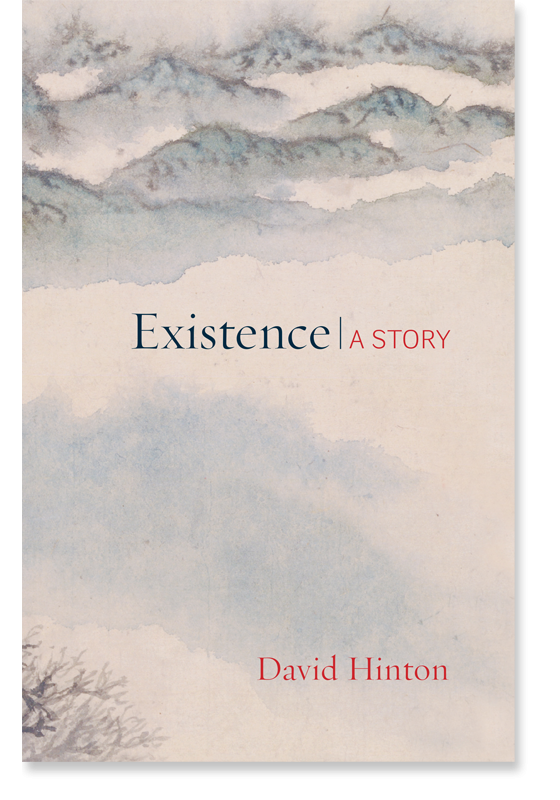Existence: A Story by David Hinton
Shambhala, £17.99 / US$18.95 (softcover)
On the face of it, it would be easy to dismiss this book as a translator’s meditation on the impossibility of translation, and more specifically on the impossibility of rendering classical Chinese into English. ‘To translate a Chinese poem into English is to fundamentally misrepresent it,’ the author boldly claims. For Hinton the problem lies not in translating the meanings of Chinese characters (although, given that they can have more than one meaning, preserving their ambiguity is an issue), but in rendering the silence between them: the things they don’t say. On this the author is an expert, having previously translated the five masterworks of classical Chinese philosophy: I Ching (late ninth century BC), Tao Te Ching (sixth century BC), Chuang Tzu (fourth century BC), Confucius’s Analects (fifth century BC) and the writings of Mencius (fourth and third century BC). Consequently it is equally easy to say that the existence that is the subject of this book is his own: a man whose profession involves creating equivalence here insisting on the philosophical and perhaps even existential difference between two languages and cultures. Inevitably, the person who comes out looking best in all that is Hinton himself, a man who makes the impossible possible. But while at times Existence can seem self-indulgent, perhaps even a little perverse, it does, on many levels, drive towards what lies at the heart of acts of creation.
Central to Hinton’s study is a painting: Shih T’ao’s Broad-Distance Pavilion, from the collection Illustrations to the poems of Huang Yan-lü (1701–02). As with much classical painting (particularly of mountain scenes), it’s largely empty save for a depiction of the artist and his travelling companion (the poet Huang Yan-lü) standing on an outcrop to the left of the painting and contemplating a mountain range that stretches out in the background towards the right. In between, there is a cloudy nothingness and the characters of Huang’s four-line poem, which describes a landscape, most of which is not visible in the painting. In chapter after chapter (in a form of meditation), Hinton retranslates and expands the poem and with it interpretations of the painting. First in an atomised way, character by character, then gradually filling in possible pronouns (not present in the Chinese) and conjunctions. Along the way he delves into Taoist and Ch’an spirituality (Shih T’ao, the last survivor of the Ming dynasty, which fell in 1644 to Manchurian invaders, was at the time of the painting a Ch’an Buddhist monk), the pictographic origins of Chinese characters (the concrete connection between Chinese words and things in the world) and the connected nature of absence and presence in language, philosophy and lived experience. ‘Much like the moment of thought arising and then falling silent in Ch’an meditation,’ Hinton writes, ‘a classical Chinese poem is a glancing gesture that returns us promptly to that generative field of silent Absence.’
‘The cosmology of Absence and Presence structures everything in ancient China,’ he continues, and part of his project is to demonstrate the ways in which classical Chinese painting and poetry, with its shifting, fluid and unstable interpretations, is a part of, rather than separate from, lived existence and thus offers a return to a primal experience of being. Where the language and art of the West portray the world from the outside (a product of Cartesian dualism, among other things), Chinese classical painting, poetry and calligraphy (between which, Hinton asserts, there is no difference) seek to be part of the changing world they ostensibly represent. Or as much a part of it as any constructed language can be. For those of you who are so contemporary that you think that all this is only of relevance to worshippers of the art of the past, you’ll find similar issues explicitly at play in a work such as The Dark Forest (2008), the second volume in awardwinning science-fiction writer Cixin Liu’s trilogy, Remembrance of Earth’s Past.
The book may at times feel slightly hippy-ish, repetitious and written with an occasional inelegance that is the opposite of the work and concepts it describes (a concept such as the universal connectedness of existence, here rendered as ‘existence-tissue’, inevitably calls to mind Kleenex advertisements), yet in Hinton’s study there is the basis of why people bother to create works of art and why those works hold a continuing fascination for those who view them.
From the Winter 2016 issue of ArtReview Asia
